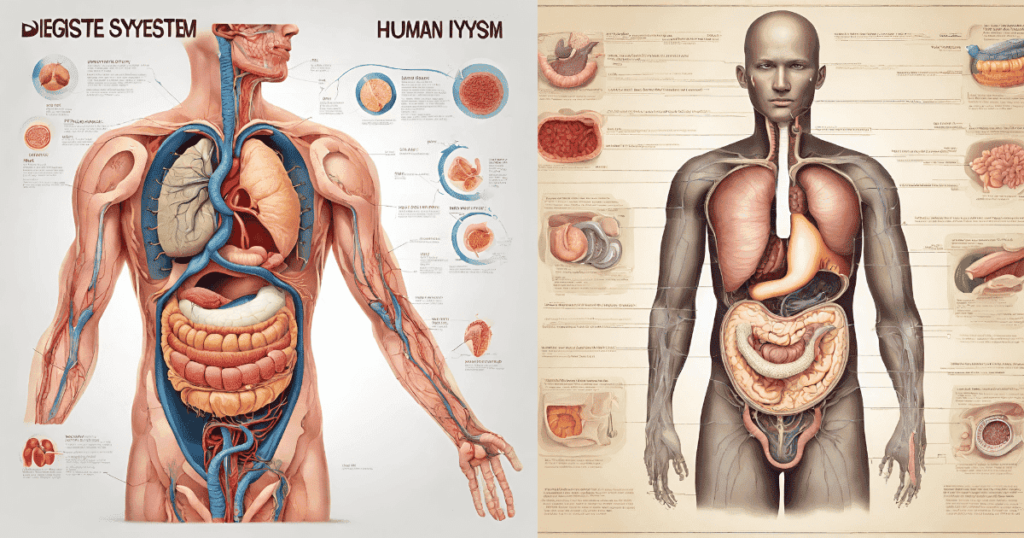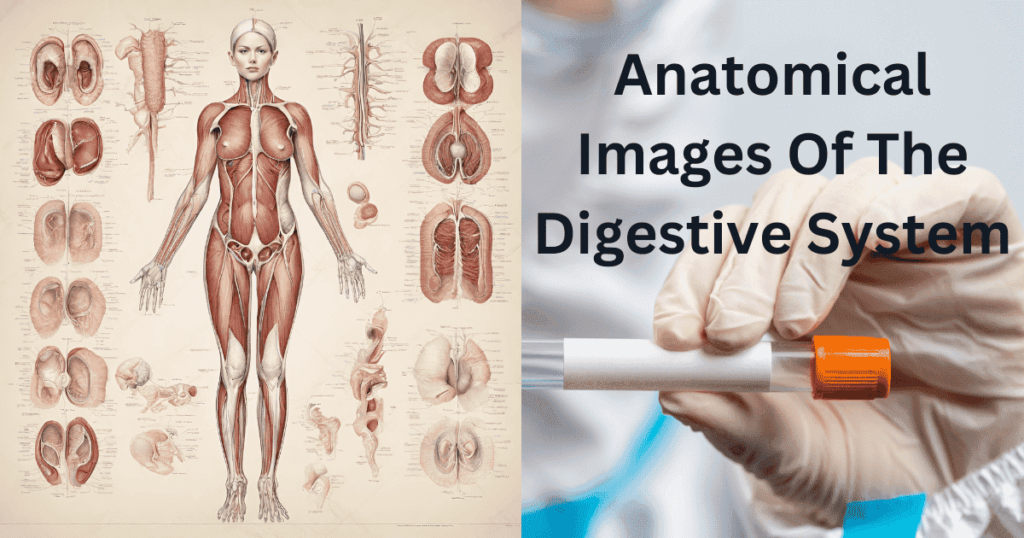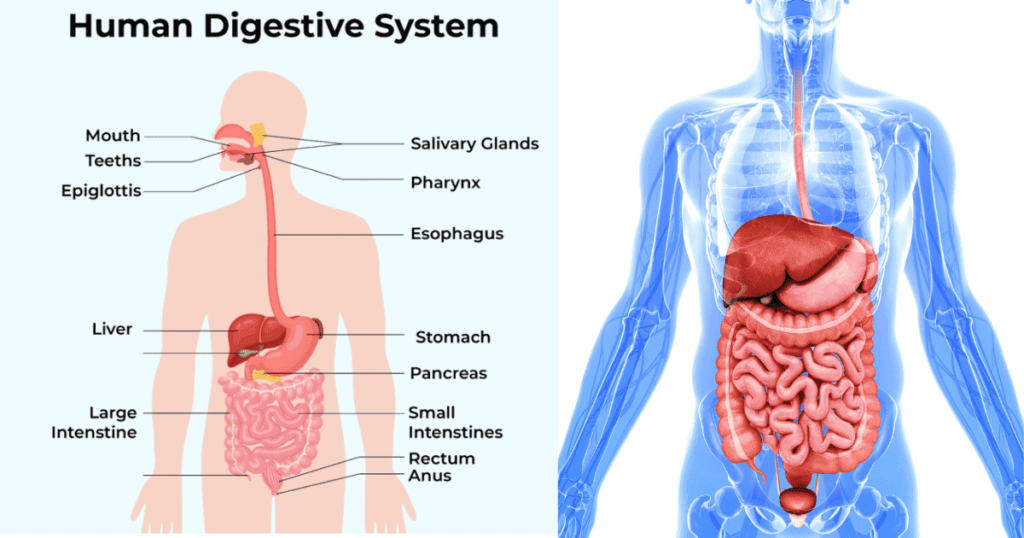Pictures of the digestive system of human can be found on websites such as Etsy, Amazon, Walmart, Britannica, Pinterest, Shutterstock, and the National Institute of Diabetes and Digestive and Kidney Diseases. These pictures show different parts of the digestive system, including the stomach, small intestine, large intestine, rectum, and anus.
The digestive system is a series of organs that food and liquids pass through when they are swallowed, digested, absorbed, and eliminated as waste. It includes the mouth, pharynx, esophagus, stomach, small intestine, large intestine, rectum, and anus. The digestive tract is an important part of the digestive system, where the process of digestion and absorption takes place.
The GI tract is a long, twisting tube from the mouth to the anus, consisting of hollow organs such as the mouth, esophagus, stomach, small intestine, large intestine, and anus.

Introduction To The Digestive System
Discover the intricacies of the digestive system through captivating pictures of the human anatomy. From the mouth to the anus, explore the organs involved in the process of digestion, absorption, and elimination of waste. Dive into the world of the digestive tract and gain a deeper understanding of its functions.
Overview Of The Digestive System
The digestive system is an intricate and fascinating network of organs responsible for breaking down food and extracting essential nutrients to fuel our bodies. This complex system ensures that we receive the necessary nutrients for growth, energy production, and overall health.
Importance Of Studying The Digestive System
Understanding the digestive system is crucial as it plays a significant role in our overall well-being. By studying the digestive system, we can gain insights into how our bodies process food, the optimal diet for specific conditions, and the impact of lifestyle choices on digestive health. Moreover, it enables us to identify and prevent digestive disorders, ensuring proper digestion, absorption, and elimination of waste.
Components Of The Digestive System of Human
The digestive system comprises several key components that work together harmoniously to carry out the intricate process of digestion. These components include:
- Mouth: The initial stage of digestion begins in the mouth, where food is broken down into smaller particles through chewing.
- Pharynx and Esophagus: The pharynx and esophagus act as a pathway for food as it travels from the mouth to the stomach.
- Stomach: Once food enters the stomach, it is further broken down through the gastric juices and enzymes present in this organ.
- Small Intestine: The small intestine is where the bulk of nutrient absorption takes place. It is made up of three parts: the duodenum, jejunum, and ileum.
- Large Intestine: The large intestine, also known as the colon, absorbs water and electrolytes from the remaining food, forming feces.
- Rectum and Anus: The rectum stores feces until elimination occurs through the anus.
Each component of the digestive system performs a specialized function to ensure the efficient breakdown and absorption of nutrients from the food we consume.
By studying the digestive system, we unveil the intricate mechanisms and processes that contribute to our overall health and well-being. It empowers us to make informed choices regarding our diet, lifestyle, and healthcare, ultimately leading to a healthier and more balanced life. So let’s delve deeper into the fascinating world of the digestive system and unlock its valuable secrets.
Anatomical Images Of The Digestive System
Discover a collection of anatomical images showcasing the digestive system of the human body, including the mouth, esophagus, stomach, small intestine, large intestine, rectum, and anus. Explore the intricate details of these organs and gain a deeper understanding of how digestion occurs.

Internal Organs Of The Digestive System
Exploring the internal workings of the digestive system reveals a complex network of organs responsible for processing food.
The Alimentary Canal
The alimentary canal, also known as the digestive tract, is a crucial part of the digestive system where food is broken down and absorbed.
The Small Intestine
The small intestine is where most of the absorption of nutrients from food takes place, playing a vital role in the digestive process.
The Large Intestine
In the large intestine, water and electrolytes are absorbed while undigested food is converted into waste before being expelled from the body.
Salivary Glands
The salivary glands contribute to the digestive process by producing saliva, which contains enzymes that aid in the breakdown of food.
From the intricate internal organs to the functions of each part, anatomical images of the digestive system provide valuable insights into the complexities of our body’s ability to process food efficiently.
Diagrams Of The Digestive System
When it comes to understanding the intricacies of the human body, diagrams of the digestive system play a crucial role. These visual representations offer a comprehensive view of the structure and function of the digestive system, aiding in education and medical diagnosis. Let’s delve into the various aspects of these diagrams and gain a deeper insight into the workings of the digestive system.
Labelled Diagram Of The Digestive System
A labelled diagram of the digestive system provides a clear depiction of the various organs and their interconnectedness within the digestive tract. Through labelling, it highlights the different components such as the mouth, esophagus, stomach, small intestine, large intestine, rectum, and anus, offering a visual guide to better comprehend the digestive process.
Structure Of The Digestive System
The structure of the digestive system encompasses a series of hollow and solid organs, each with distinct functions. From the mouth to the anus, the twisting tube of the gastrointestinal tract includes organs such as the esophagus, stomach, and both small and large intestines. Additionally, the liver, pancreas, and gallbladder contribute to the overall functionality of this intricate system.
Diagram Of The Stomach
A specific focus on the diagram of the stomach allows for an in-depth examination of its anatomy and function. The inner lining, known as the mucosa, undergoes changes in response to the stomach’s fullness, an aspect that is visually represented in the diagram. Understanding the structure of the stomach aids in comprehending its role in the digestion and processing of food.
Parts Of The Digestive System
Exploring the various parts of the digestive system, including the mouth, pharynx, esophagus, and different sections of the intestines, contributes to a holistic understanding of the digestive process. By visually dissecting the system into its individual parts, a clearer comprehension of their functions and interconnectedness is achieved.
System Drawing Of The Digestive System
A system drawing of the digestive system offers an extensive visual portrayal of the entire gastrointestinal tract, providing a comprehensive overview of its structure and organization. This detailed illustration serves as a valuable educational tool for students, practitioners, and individuals seeking insights into the complexities of the digestive system.

Function Of The Digestive System
The digestive system is a critical part of the human body, responsible for breaking down food, absorbing nutrients, and eliminating waste. It performs several essential functions to maintain overall health and well-being.
Digestion And Absorption
In the digestive system, food undergoes the process of digestion, where it is broken down into smaller, more easily absorbable components. The absorbed nutrients are then transported to the bloodstream by the intestine, where they provide energy and nourishment to the body.
Role Of Enzymes
Enzymes play a vital role in the digestive system, as they facilitate the breakdown of food into simpler forms so that they can be easily absorbed by the body. Each enzyme serves a specific function in the digestion process, ensuring efficient nutrient absorption.
Movement Of Food Through The Digestive System
Food moves through the digestive system via a series of coordinated muscle contractions known as peristalsis. This movement ensures that food travels from the mouth, through the esophagus and stomach, and finally to the small and large intestine for further digestion and absorption of nutrients.
Assimilation Of Nutrients
The digestive system is responsible for the assimilation of nutrients, ensuring that essential vitamins, minerals, and other vital substances are absorbed to support various bodily functions such as metabolism, growth, and repair.
Elimination Of Waste
Once digestion and absorption are complete, the digestive system expels the remaining waste material from the body through the process of elimination. This ensures the removal of toxins and unwanted substances, contributing to overall health and well-being.

Common Digestive System Disorders
Common Digestive System Disorders:
Gastroesophageal Reflux Disease (gerd)
Gastroesophageal Reflux Disease (GERD) is a chronic digestive disorder characterized by acid reflux from the stomach into the esophagus, causing symptoms like heartburn and regurgitation.
Ulcers
Ulcers are sores that develop on the lining of the stomach, small intestine, or esophagus, often caused by the bacterium Helicobacter pylori, prolonged use of NSAIDs, or excessive alcohol consumption.
Inflammatory Bowel Disease (ibd)
Inflammatory Bowel Disease (IBD) refers to chronic conditions like Crohn’s disease and ulcerative colitis that cause inflammation in the digestive tract, leading to symptoms such as abdominal pain, diarrhea, and weight loss.
Irritable Bowel Syndrome (ibs)
Irritable Bowel Syndrome (IBS) is a common functional disorder of the digestive system characterized by symptoms like abdominal pain, bloating, diarrhea, and constipation, often triggered by stress or certain foods.
Gallstones
Gallstones are solid particles that form in the gallbladder and can cause symptoms like abdominal pain, nausea, and jaundice, often attributed to an imbalance in the chemical composition of bile.

Frequently Asked Questions For Pictures Of The Digestive System Of Human
What Does A Healthy Stomach Look Like Inside?
A healthy stomach looks like this: Mucosa lining with ridges when empty, flattening when full. Submucosa includes tissues, blood vessels, nerves.
What Are The 7 Parts Of The Digestive System?
The 7 parts of the digestive system are the mouth, esophagus, stomach, small intestine, large intestine, rectum, and anus.
What Does A Digestive System Look Like?
The digestive system is a long, twisting tube made up of hollow and solid organs. These include the mouth, esophagus, stomach, small intestine, large intestine, and anus. The liver, pancreas, and gallbladder are part of the system. The small intestine is where final digestion and absorption take place.
Where Does Final Digestion Take Place?
Final digestion takes place in the ileum of the small intestine, where the last nutrients are absorbed.
What Are The Main Organs In The Digestive System?
The digestive system consists of the mouth, esophagus, stomach, small intestine, large intestine, liver, pancreas, and anus.
Why Is The Digestive System Important For The Body?
The digestive system breaks down food into essential nutrients that the body needs for energy, growth, and repair.
How Does The Digestive System Absorb Nutrients?
Nutrients are absorbed through the walls of the small intestine into the bloodstream before being carried to different parts of the body.
Conclusion
Explore the intricate journey of the human digestive system through captivating images and informative descriptions. Understand the complexity of organs like the stomach, small intestine, and colon. Witness the dynamic inner workings that facilitate digestion, absorption, and waste elimination. Unveil the marvels of the digestive tract in vivid detail.

